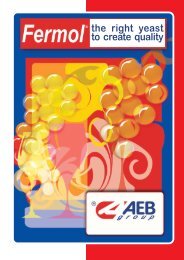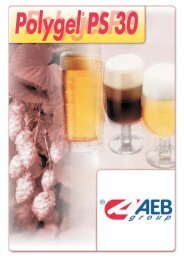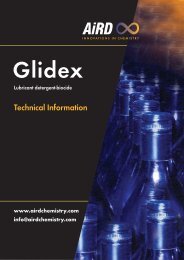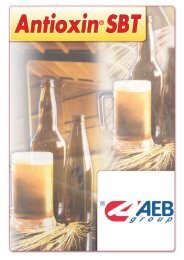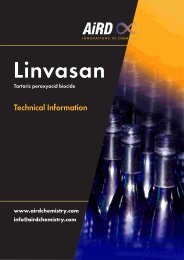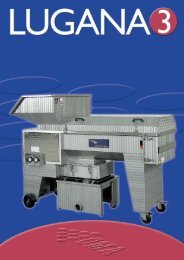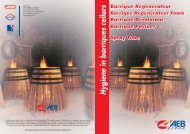AMORIM CORK.pdf - SWAT
AMORIM CORK.pdf - SWAT
AMORIM CORK.pdf - SWAT
- No tags were found...
Create successful ePaper yourself
Turn your PDF publications into a flip-book with our unique Google optimized e-Paper software.
<strong>CORK</strong>T H E N A T U R A L C H O I C E
C O R K – T H E N AT U R A L C H O I C EFor centuries, cork has proved to be the most effective closure forwine, protecting its qualities and allowing it to develop andimprove over time. Dom Pérignon first used cork in champagneand started a revolution in wine bottling. It is still the winemaker’sfirst choice and is recognised the world over as the ideal partnerfor wine. Amorim, the world’s largest manufacturer of corks forwine, has worked with this remarkable natural material since 1870.Cork’s inert nature, its impermeability to liquids, its flexibility,its ability to compact and expand and its extraord i n a ryresilience, makes it second to none as a reliable stopper forwine. Cork allows wine to achieve its full ageing potential. It isoverwhelmingly preferred by consumers.Cork is one of the few forms of packaging that is completelye n v i ronmentally friendly – it is natural, renewable, fully re c y-c l a b l e and biodegradable.
A S U S TA I N A B L E R E S O U R C EThe continuing demand for corks from the drinks industry helpsensure the future of the vast forests of cork found around thewestern Mediterranean basin. In Portugal alone there are morethan 670,000 hectares of cork forests, which produce more thanhalf the world’s cork.The area under cork forest is growing by 4 per cent a year,thanks to a large-scale re-afforestation programme.Management of the cork forests in Portugal – from cultivation toharvesting – is strictly controlled. The trees cannot be cut downwithout permission and the bark can only be stripped once everynine years.Cork is a truly sustainable re s o u rce. The cork oak tree has al i f e s p a n of around 170 – 200 years during which time it will bestripped around 15 – 18 times. Today’s forest is relatively young– the average cork oak is 72 – 75 years – ensuring sufficient corkto supply the world’s winemakers for the next 100 years.A cork tree has to be at least 25 years old before the first harvestand it is not until the third harvest that the bark can be used forthe production of wine corks. Bark from the first two harv e s t s( Vi rgin and Secondary) are used for other cork products.
The harvest takes place between June and September because atthis time of the year the tree is growing. This means that thebark can be easily removed from the trunk and a new outerskin grows quickly to protect the inner bark. Stripping the outerbark is a very delicate operation carried out by skilled workersusing special axes.The oldest cork oak tree, the “Whistler tree” is more than 215years old. When last harvested in 1991 it yielded 1,200kilogramsof cork which produced around 100,000 wine corks.
A G U A R A N T E E O F Q U A L I T YThe scale of Amorim’s operation gives it access to the best qualityraw material. Amorim’s corks are produced under meticulousquality control using the most modern equipment.After harvest the bark is seasoned for six months in the open air,stacked on pallets above the ground. It is boiled in water at100˚C for 90 minutes to remove contaminants. The planks arethen left to stabilise for two to three weeks. The bark is sortedinto quality categories before being boiled and dried again. Onlythe best quality bark is chosen for natural cork stoppers anddiscs for sparkling wine and Twin Top ® corks. The corks arepunched mechanically or by highly skilled workers, who canpunch up to 20,000 corks a day.These corks are machine-sorted into seven grades beforebeing sterilised in a hydrogen peroxide solution. They are thendried to 6 per cent – 8 per cent humidity, sorted again – t h i stime by hand – branded according to customers’ specificationsand, finally, given a surface coating to facilitate insertionand extraction.The coded batches are vacuum-packed in polyethylene bags intowhich sulphur dioxide is introduced.
The corks undergo exhaustive quality control and testing ateach stage of processing. Amorim has testing laboratories ineach plant, as well as its central laboratory. In addition to tasteand sensory analysis, the battery of tests cover humidity andm i c robiological content, capillarity, re c o v e ry, sealing ability andp e rf o rmance over time.To ensure optimal performance, Amorim provides guidelines forwinemakers on storing and handling corks. These include:● Storing in cool conditions – clean, well ventilated, free fro mvolatile or aromatic products, temperature of 15 – 20˚C, re l a t i v ehumidity of 50 – 70 per cent.● C o m p ression not exceeding 15.5mm for a 24mm diameter cork.● Rapid insertion to avoid creasing at lower end of cork.● Storing bottles upright for a specified period after corking, toallow the cork to recover and ensure a perfect seal.● Head space of at least 15mm between the cork and the wine at20˚C to accommodate temperature variations.● Corker jaws set to correct diameter – good maintenance ofcorker. Using CO 2 or vacuum during bottling to minimiseinternal pressure and the risk of leakage.
T Y P E S O F C L O S U R EAmorim produces a wide range of corks that meet thehighest technical perf o rmance standard s .NATURAL <strong>CORK</strong>SPunched whole from the best qualitycork bark, then sterilised and finishedto the highest quality standards, thenatural wine cork is unsurpassed as awine closure.The secret to its performance lies in itsunique cell structure, which no technologyhas been able to emulate. C o r kconsists of a honeycomb structure oftiny impermeable cells filled with anair-like gas – about 40 million percubic centimetre. This stru c t u remakes cork very easy to compress andso less liable to damage from corkingmachines. (The cork also containslenticels or pores that run across thegrain. Because natural corks arepunched along the grain, t h e s elenticels do not come into contactwith the wine.)The cushion-like cork cells have elasticm e m o ry. When compressed theyc o n s t a n t l yt ry to re t u rn to their originalsize, thus maintaining a tight evenseal. Being elastic, cork is also moretolerant than other materials ofchanges of temperature and pressure.Moreover, because cork recovers itsshape gradually, it is able to conformto the shape of the bottle without thef o rmation of micro c reases that wouldallow oxygen migration. The samecharacteristic allows it to compensatefor imperfections in the bottle neck.It has taken many years and today’stechnology to understand why cork issuch an outstanding wine closure, butits performance over time speaks foritself.The discovery in 1956 of a wine dated1789 in a cellar in Indre et Loire andthe 1998 recovery of champagne fromthe Baltic Sea after 80 years – bothwith the contents well preserved –stand as a testimony to natural cork’sperformance as a wine closure.TWIN TOP ® <strong>CORK</strong>SBased on the successful design of thesparkling wine cork, Twin Top ® is a highquality technical cork that combinesthe best raw material with the latesttechnology and experience of Amorim.Twin Top ® corks have discs of finenatural cork cut across the grain, ateither end and a granulated corkbody made from high-grade naturalcork left over after cork punching.
The discs undergo a re v o l u t i o n a rynew process of ‘hydro d y n a m i cextraction’ that removes contaminantsf rom the cork.This process, called INOS II, is thew o r l d ’s most advanced and eff i c i e n tcork decontamination technology. Itis the result of six years intensives c i e n t i f i cand technological re s e a rc h ,and is exclusive to Amorim.I N OS II completely washes theinner section of the cork, pumpinga purified solution into and out ofthe cork’s lenticels or pores. Thepumping action extracts any re s i d e n tp a rticles. The purified hot waterextracts any substances that wouldbe otherwise dissolved by the wineand affect its flavour.In trials in the USA, Europe andAustralia, Twin Top ® has passed themost demanding physical, chemical,microbiological and oenological tests.It provides the highest possible qualityat a competitive, stable price.F rom June 1999, Amorim will pro d u c eTwin Top ® in Australia.Twin To p ® is a re g i s t e red brand name of Amorim.SPARKLING WINE <strong>CORK</strong>SThe successful fore runner to Tw i nTo p ® , the cork for sparkling wine isthe product of a nine-year re s e a rc hp rogramme by Amorim.At one end these corks have two orthree discs of fine natural cork, whichundergo a sophisticated washing anddeodorising process. This re m o v e scontaminants that could otherw i s eimpart flavours to the wine.The body is made from a singlemoulding of high-quality naturalgranulated cork, giving it uniformphysical and mechanical characteristics.Sparkling wine corks undergo the moststringent quality control proceduresand meet the highest physical,chemical, microbiological and oenologicalstandards.BAR TOP <strong>CORK</strong>SThe bar top cork consists of a smallnatural cork, rounded or chamferedat one end with a cap at the other end– of wood, porcelain, metal or hardsynthetic materials. It is commonlyused in fortified wines, spirits and fineolive oils.The bar top cork has a special surfacet reatment to improve the natural sealingproperties of the cork and allow thestopper to be easily removed andreplaced over time.COLMATED <strong>CORK</strong>SColmated cork is made from lowergrade natural cork, having some larg e rlenticels or structural imperfections.After the corks are punched andwashed, the lenticels are filled with amixture of fine natural cork particlesand a food-grade natural latex to sealthe cork and improve the perf o rm a n c eof the stopper. A special surf a c et reatment is applied to ensure theintegrity of the stopper.
Amorim is the world’s leading producer of cork. Its heritage goesback 130 years and its operations span the globe. Amorim carr i e sout one fifth of the world’s cork processing and employs 35d i s t r i b u t i o n companies worldwide to handle its cork products.Each year Amorim produces over 3 billion wine corks.Amorim is at the forefront of technological advances in the corkindustry, spending over $US 6 million (£4 million) a year onre s e a rch and development to help fulfill its quality commitment tothe wine industry. Amorim strongly supports the European CorkFederation’s (C.E. Liège) Code of Practice Two, to be introducedduring 1999, which includes refinements to production pro c e s s e sand the introduction of company audits to ensure that compliancewith standard s .Amorim’s advanced technology and exhaustive quality controlsenable it to offer winemakers throughout the world a truly highperformance product.Already 99.5 per cent of Amorim’s natural wine corks pass themost rigorous testing. Amorim’s goal is to produce a completelyfault free natural cork product in the near future.
The world’s leading winemakers place their tru s tin corks made by Amorim.Amorim, PO Box 1 - 4536 Santa Marie de Lamas Codex - Port u g a lTelephone (351 2) 747 5500, Fax 351 (2) 747 5501, E-mail gcral@amorim-irm a o s . p t



